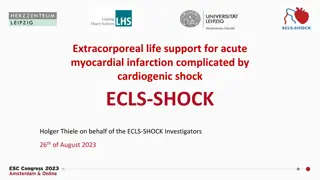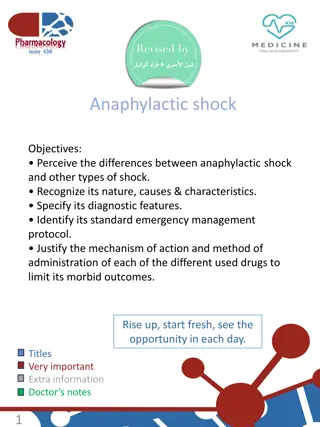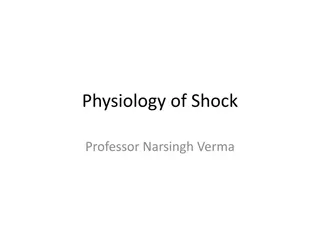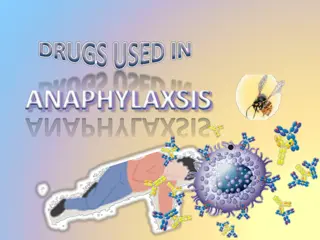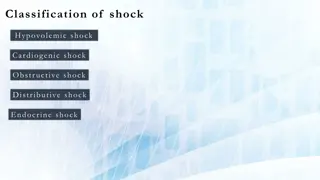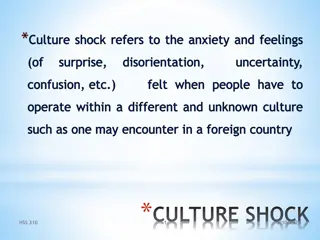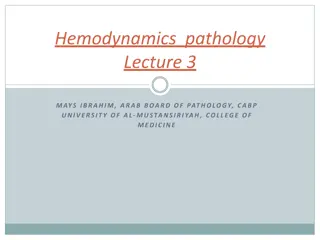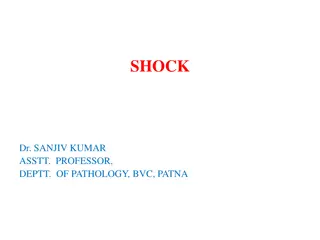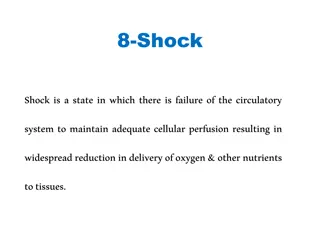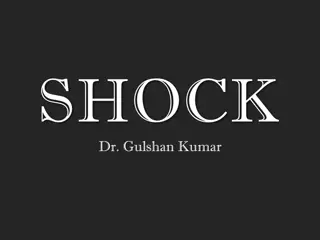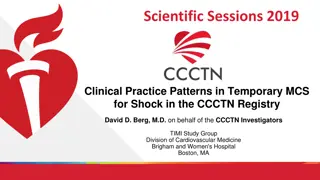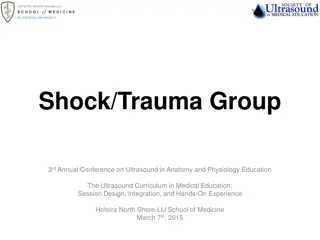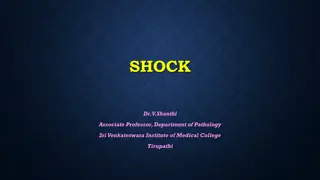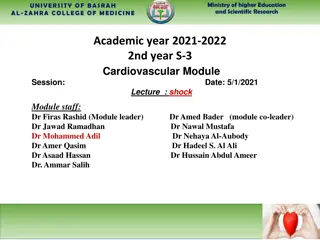Understanding Hemodynamics in Left vs. Right Heart and Cardiogenic Shock
Explore the hemodynamic differences between the left and right heart, the etiologies of cardiogenic shock, and the importance of right heart catheterization in managing this critical condition. Learn about key parameters such as PCWP, RAP, CO, and more that play a crucial role in assessing cardiac function and guiding treatment decisions in patients with cardiogenic shock.
Download Presentation

Please find below an Image/Link to download the presentation.
The content on the website is provided AS IS for your information and personal use only. It may not be sold, licensed, or shared on other websites without obtaining consent from the author. Download presentation by click this link. If you encounter any issues during the download, it is possible that the publisher has removed the file from their server.
E N D
Presentation Transcript
Left vs. Right Heart Left vs. Right Heart Cardiogenic Cardiogenic Shock: Shock: What Are the What Are the Hemodynamics Hemodynamics? ? Jeff Davis, RRT, RCIS
Disclosures Jeff Davis has nothing to disclose
Shock Hippocrates perhaps first to describe shock French surgeon Henri Francois Le Dran, first person to use the term shock in 1737 The rude unhinging of the machinery of life Samuel Gross, 1872 End-organ cellular dysfunction due to tissue hypoperfusion Cardiogenic, Hypovolemic, Obstructive, Distributive (Anaphylactic, Septic, Neurogenic)
Etiologies of Cardiogenic Shock ACS, STEMI, NSTEMI LV Failure, RV failure Mechanical Complications MR, VSD, Rupture, Tamponade Advanced Heart Failure Post Surgery Vasodilatory
Contemporary Management of Cardiogenic Shock: A Scientific Statement From the American Heart Association, Volume: 136, Issue: 16, Pages: e232-e268, DOI: (10.1161/CIR.0000000000000525)
The Case for Right Heart Caths in Cardiogenic Shock Most common cause of in-hospital mortality after AMI, rates > 50% for nearly 2 decades Short-term stabilizing effects of vasopressors/inotropes offset by adverse effects on afterload and oxygen demand, resulting in end-organ hypoperfusion, lactic acidosis, and refractory shock Recent scientific statement by the AHA suggests that RHC may play important roles in the diagnosis and management of CS Not all CS cases are the same
What are the Important Hemodynamics? LEFT HEART RIGHT HEART 4. PCWP = 5. Left atrial Pressure (8-12 mmHg)1 1. RAP +/or CVP (0-8 mmHg)1 6. LVEDP (5-12 mmHg)2 2. RVSystolic/Diastolic (15-30/0-8 mmHg)1 7. CO (4-7 L/min) via thermodilution (TD) or CCO PA Catheter3 3. PA Systolic/Diastolic (15-30/8-12 mmHg)1 8. Blood Pressure (100-140/60-90 mmHg)3 3. SVO2 (70-75%)3,4 CALCULATED DATA MAP (70-100 mmHg)=2/3*Diastolic Pressure + 1/3*Systolic Pressure3 CALCULATED DATA Right heart pumps against PVR (120-250 dynes*sec/cm-5) = 80*(mean PA-PCWP)/CO3 CO (4-7L/min)= FICK eqn = (BSA 120)/ 0.1 1.36 (SaO2-SvO2) Hgb3 PAPi (>0.9) = (PASP-PADP)/CVP CI (2.5-4.5L/min/m ) = CO/BSA3 1. Marso SP, Griffin BP, Topol EJ. Manual of Cardiovascular Medicine. Philadelphia: Lippincott Williams & Wilkins, 2000. Kern MJ. The Cardiac Catheterization Handbook, 4th ed. St. Louis: Mosby Inc; 2003. Carey CF, Lee, HH, Woeltje KF. The Washington Manual of Medical Therapeutics, 29th ed. Philadelphia: Lippincott-Raven Publishers, 1998. Marino PL. The ICU Book, 2nd ed. Baltimore: Williams & Wilkins, 1998. Naidu S, et al. Circulation. 2011;123(5):533-543. Fincke J, et al. J Am Coll Cardiol. 2004;44:340-348. L Heart pumps against the SVR (SVR 800-1200dynes*sec/cm-5) = 80* (MAP-CVP)/CO3 2. 3. CPO (>1.0 Watts) = (COxMAP)/4515,6 4. 5. 6. Salvatore F Mannino, DO, MA, FACC, FSCAI
Cardiogenic Shock Criteria SBP < 90 mmHg for > 30 minutes (or inotropes/vasopressors to maintain SBP >90) Evidence of end-organ hypoperfusion Lactate > 2 mmol/L Fick CI < 1.8 L/min/m2 w/o inotropes/vasopressors or <2.2 with inotropes/vasopressors PCWP > 15 mmHg (18); RVEDP > 10-15 mmHg Cardiac Power Output (CPO) < 0.6 Watts Pulmonary Arterial Pulsatility Index (PAPi) < 0.9
What Type of Cardiogenic Shock? Contemporary Management of Cardiogenic Shock: A Scientific Statement From the American Heart Association, Volume: 136, Issue: 16, Pages: e232-e268, DOI: (10.1161/CIR.0000000000000525)
Value of a Right Heart Cath Cardiac Power Output (CPO) Pulmonary Arterial Pulsatility Index (PAPi) Assesses right heart function PAPi = PA(sys) PA(dias)/RA PAPi (normal) (25-8)/4 = approx. 4.0 PAPi < 0.9 associated with right ventricular compromise and need for RV support Assesses left heart contractility (flow and SVR) CPO = MAP x CO/451 CPO (normal) = (93x5)/451 = approx 1.0 Watts CPO < 0.6 Watts (0.53) associated with increased mortality
Cant Forget the Right Heart Right Heart Dysfunction PAPi < 0.9 CVP > 15 mmHg CVP/PCWP > 0.63 CI < 2.2 L/min/M2 with Left support Cardiogenic Shock, Volume: 8, Issue: 8, DOI: (10.1161/JAHA.119.011991)
Tips and Tricks Pressure may not reflect true flow if vascular impedance is abnormal Meticulous technique for hemodynamic system Balance and calibrate Systolic pressure amplification, mean pressure may be more accurate Recording artifacts Underdamping & Overdamping Respiratory variation, PEEP, Mechanical ventilation
Case for the Audience: Do we need any Support? Right or Left? 64 yo male STEMI, Hx: HTN, COPD, DM, PAD, CKD, presenting SOB & HF Troponin 1.4 ng/L Cr 1.4 mg/dL BP 88/56 mmHg on dopamine drip 15-20% EF via echo Hemodynamics MAP 60 mmHg CO 2.8 L/mln, CI 1.4 L/Min/M2 RA/CVP 20mmHg PA 54/32 mmHg LVEDP 34 mmHg CPO = 60 x 2.8 / 451 = 0.4 PAPi = (54 32) / 20 = 1.1
Thank You Jeff Davis, RRT, RCIS jdavis@fsw.edu



